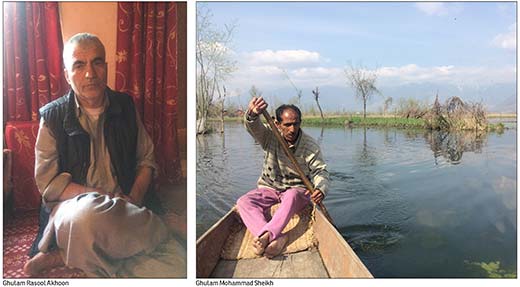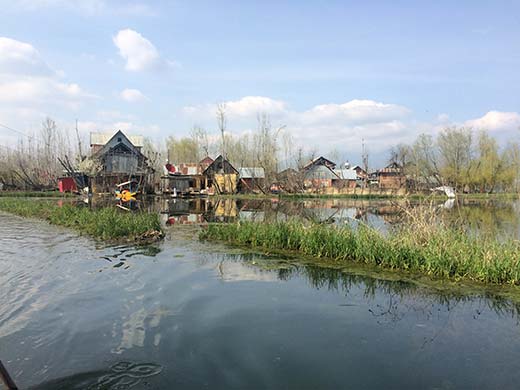Floating vegetable markets in Dal interiors, no more sound buzzing as flood waters and subsequent rains wreaked havoc on the floating vegetable gardens of the lake. With government apathy, the people associated with the trade have been left without any means of livelihood. Saima Bhat reports the desperation of these Dal dwellers
Hustle and bustle in Srinagar’s floating market in Dal Lake, one among the world’s five floating markets, starts much before dawn. By the time most people in city leave cozy beds, the farmers of Dal are done with their business deals and they return to their home happily. But post floods the situation has changed and these people have been out of business for more than seven months now. These growers claim it needs them a year to grow vegetables again and at least a decade to re-grow Kashmiri Lotus stem, Nadru.
Selling of vegetables and flowers in the floating market is the only source of income for most of the growers living inside and on peripheries of Dal Lake. Every day by 5 AM, they were usually ready with their fresh stocks of colourful vegetables and flowers.
Like other wholesale markets the dealer in floating boats comes to the grower for trade and the latter has to remain ready with all his stock in shikara in any of the four floating markets, Tind Mohalla and Kand Mohalla market, Kani Kachi bridge market, Anz Khoed market and Khair Gudier (mostly for animal fodder) in interiors of Lake.
The boats keep bumping into each other all the time, so the shifting of stock from a grower to retailer is not difficult. Then these boats sell off the stock to the houseboats and to the waiting load carriers at different ghats of Lake.
The vegetables from floating market usually attract customers for these being organic, fresh and tasty. Besides vegetables and flowers, handicrafts and saffron too is sold here. On an average, every morning this market was believed to do a transaction worth 10 to 20 lakh rupees, say growers, who now are jobless. There are no official figures present with the agriculture department.
Altaf Aijaz Andrabi, Joint director, agriculture department Kashmir says, “how can we have the sale records of this market when it has been officially banned by the High Court, for being one of the major pollutants of the Dal Lake.”
But now the shikara people don’t get delighted when a visitor asks them for this market. “Visitors used to book in advance for visiting this market and each ride meant more than Rs 600 depending upon on which side a visitor starts his journey. But now, nothing is left there,” shares a Shikara wala.
A grower Ghulam Rasool Akhoon, in his fifties, who is the general secretary of Dal dwellers association, has never witnessed the type of destruction which was created by floods in September 2014. As per him, it has happened for the first time that the people of his community are out of business for such a long time now.
“First it was floods and then the extensive rainfall in February and March. The September flood inundated vegetable lands and the demarcations used to grow for lotus stems. The water remained there for almost three months and when the water level receded, we growers decided to start again. We started sowing seeds for next season but due to heavy rainfall the seeds for nadru were dispersed. And that dream too was washed away. Now we are not left with any kind of seeds to support us for future.”
He says the interiors of Lake are still facing flood like situation as the water level is still above normal levels.
Around 12,000 kanals of land along the Dal Lake were used by these lake farmers for cultivation of vegetable but now the locals claim the situation is such that they don’t have enough resources to feed their children.
 Akhoon, who deals mostly with lotus stems, adds, “Besides, other 27,000 kanals of lake were specifically used for cultivation of lotus stem and that crop is destroyed for at least next 10 years. It means a loss of Rs 35 crores per annum.” He himself has sold his six cows because he had no source of income to purchase fodder for them. Almost every household have sold off their domestic animals.
Akhoon, who deals mostly with lotus stems, adds, “Besides, other 27,000 kanals of lake were specifically used for cultivation of lotus stem and that crop is destroyed for at least next 10 years. It means a loss of Rs 35 crores per annum.” He himself has sold his six cows because he had no source of income to purchase fodder for them. Almost every household have sold off their domestic animals.
And now as the budget 2015-16 has been presented, Akhoon feels further shattered. “I read the fiscal plan thoroughly and I was surprised to know that there was nothing for the rehabilitation of around 26000 people who are entirely dependent on floating lands. I want to ask these lawmakers, did floods affect horticulture only?” He further adds, “Post floods, government officials came for assessing the damage of our houses and cheques were given but what about our livelihood. I had high hopes but now we are disappointed.”
For Ghulam Mohammad Sheikh, a farmer living in Tang Khai, the loss of floating market means loss to at least five different sections of people: growers, skilled laborers, the dealers, vendors on streets and tea stall owners. His house too was damaged in recent floods but the loss of his livelihood is giving him more pain.
But the main markets in city are not running short of vegetables barring the Dal Nadur. “We have enough of vegetables present in market that we get from other big markets like Bugam in district Budgam or from outside state,” says Wasim Hassan, one of the vegetables importers at Fruit Mandi, Parimpora.
“Every day I row my shikara for at least 2 hours to reach the ghat near Nehru Park, where I earn 200 or 300 rupees a day. It is very difficult to manage family from this meager amount,” says Sheikh.
The other floating markets in world are Damnoen Saduak floating market in Ratchaburi, Thailand, Floating market in the Solomon Islands, Bangkok’s Taling Chan floating market, Floating Markets at Mekong Delta, Vietnam and one in the Kerala.
But in our own floating market people are battling hard to keep themselves alive. “What is left now is the hope for a good tourist season,” says Akhoon.
